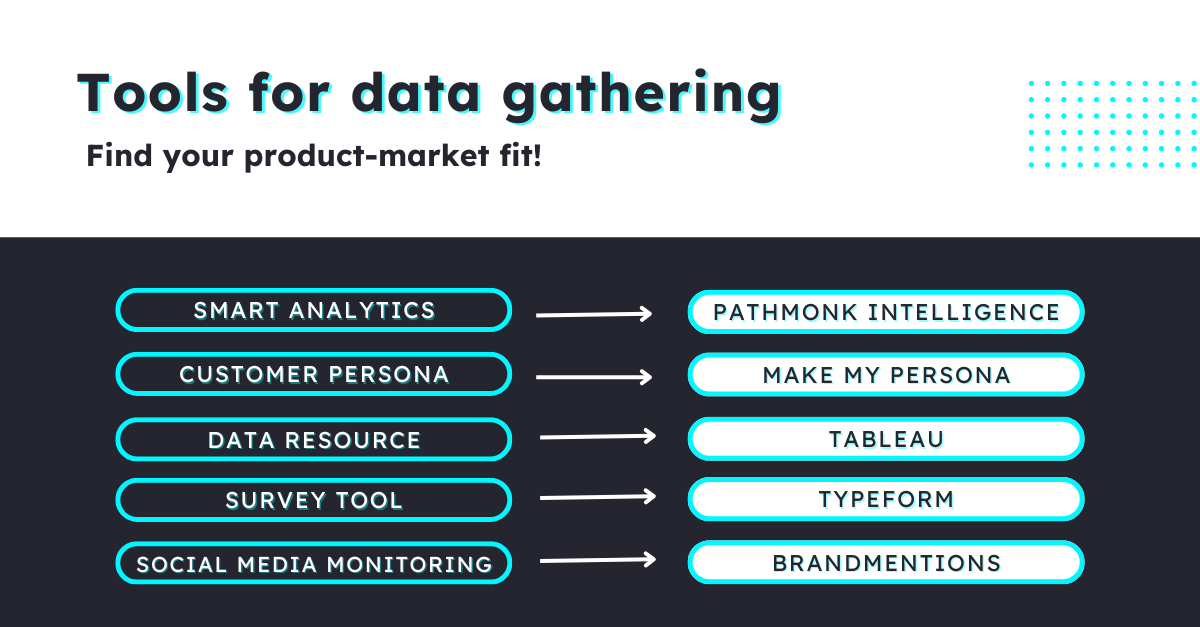
Does product-market fit automatically result in high-volume sales? The short answer is no. Product/market fit does not automatically guarantee high-volume sales, but it is a crucial factor that can significantly contribute to achieving them. Product-market fit occurs when a product satisfies a strong market demand and effectively meets the needs and preferences of its target customers.
And now a longer answer so we can better understand the short one 🙂
Table of Contents
Why Does PMF Not Guarantee Market Success?
Let’s delve deeper into each point regarding why product/market fit doesn’t automatically lead to high-volume sales and explore the origin of this common misconception.
1. Market Awareness
Even if a product perfectly meets market needs, it won’t generate sales if potential customers are unaware of its existence. Effective marketing strategies such as advertising, content marketing, social media engagement, and public relations are essential to building awareness. These efforts communicate the product’s benefits and differentiators to the target audience and stimulate interest and demand.
2. Sales and Distribution Channels
Access to customers is crucial. If the product isn’t accessible in the channels where target customers expect to find it, sales will lag. This involves selecting the right retailers, online platforms, or direct sales strategies that align with consumer habits and preferences. Effective distribution networks ensure that once demand is stimulated, the product is readily available to fulfill that demand.
3. Scaling Capabilities
A product’s ability to meet large-scale demand hinges on the company’s operational capacity. This includes manufacturing, workforce, and logistics. If a company cannot produce enough units due to limited capacity or supply chain issues, or if it cannot manage customer service effectively, sales will suffer regardless of the demand.
4. Competitive Landscape
Competitors can significantly influence the success of a product, even one that fits the market well. Competitors might offer similar benefits with added features, lower prices, or stronger brand loyalty. To outpace competitors, a company needs to innovate continually and possibly adjust its marketing, pricing, or product itself to maintain a competitive edge.
5. Economic and External Factors
External factors such as economic recessions, shifts in consumer sentiment, technological changes, or new regulations can impact sales volumes unexpectedly. For instance, a recession can reduce consumer spending overall, affecting sales regardless of the product’s market fit.
6. Customer Acquisition and Retention
Acquiring and retaining customers is about more than just meeting a market need. It involves ongoing engagement and excellent customer service. Building customer loyalty through consistent quality, responsive support, and iterative improvements based on customer feedback can sustain sales momentum over time.
Origin of the Myth
The myth that product/market fit automatically leads to high sales volumes likely stems from the visible success stories in the business world, particularly in the tech industry, where rapid growth and success often seem tied directly to product innovations that meet emerging market needs. Examples like Uber, Airbnb, and Facebook, where innovative solutions met underserved demands, give the impression of an automatic transition from market fit to high sales.
However, these stories often underplay the intensive marketing efforts, strategic planning, and operational scaling that were also necessary to achieve those high sales volumes.
This simplification has led many to overestimate the power of product/market fit alone, without considering the complex interplay of other essential factors in a product’s success. The reality is that while product/market fit is a critical foundation, it’s the combination of multiple strategies and capabilities that drives high-volume sales.
Which Two Actions Help Startup Companies Achieve Product-Market Fit?
Achieving product-market fit is essential for startups, as it ensures the product they offer meets the needs and demands of their target market effectively. Two key actions that can help startups achieve this crucial alignment are:
1. Continuous Customer Feedback and Iteration
Engaging with the target customer base continuously to gather feedback is vital. This can be achieved through various methods such as surveys, user testing, interviews, and usage data analysis. The insights help startups understand what aspects of the product resonate with the users and what elements fall short.
Steps involved:
- Build a Minimum Viable Product: Start with a basic version of the product that includes the core features necessary to solve the primary problem for your target users.
- User Testing: Put the MVP in the hands of real users in your target market as early as possible.
- Gather Feedback: Collect detailed input on the user experience, usability, and value delivered by the product.
- Iterate Quickly: Use that information to make informed adjustments and improvements to the product. This might mean refining features, removing what doesn’t work, or adding new elements that customers desire.
2. Pivot Based on Market Response
A pivot involves fundamentally changing the direction of a product or business strategy based on feedback and market demand. This can mean altering the product, target audience, or even the business model. Pivoting can be crucial when initial assumptions about the market are disproven by real-world interactions with customers.
Steps involved:
- Market Analysis: Continuously analyze market trends and customer behavior to identify potential misalignments or new opportunities.
- Decision to Pivot: If feedback indicates that the current product or approach isn’t meeting the market’s needs effectively, consider a pivot. This decision should be driven by data and customer insights.
- Implement Changes: Implement the necessary changes to the product or strategy. This might involve targeting a different customer segment, changing the product’s feature set, or even overhauling the business model (e.g., from a product to a service).
Pivoting requires courage and flexibility but can be critical for finding the right market fit if the initial assumptions do not hold up under real-world conditions.
How Can I Evaluate the Results?
Evaluating whether your startup has achieved product-market fit involves looking at a range of quantitative and qualitative indicators that can provide insight into how well your product satisfies market demands. Here’s a structured way to assess these results:
Usage Metrics
- Engagement Metrics: Track how frequently users engage with your product and for how long. High engagement levels often indicate that your product is valuable to users.
- Retention Rates: Analyze how many users continue to use the product over time. A high retention rate suggests that your product continues to meet user needs after the initial adoption.
- Churn Rate: The rate at which you lose customers can signal dissatisfaction or lack of ongoing relevance. Lower churn rates are typically indicative of better product-market fit.
Ebook: Predictive analytics for business strategy
Dive deep into the future of business intelligence and learn how to leverage AI for strategic advantage.

Growth Metrics
- Growth Rate: Measure the rate at which new users adopt your product. Organic growth, especially, is a strong indicator of product-market fit, as it suggests that existing users find enough value in the product to refer others.
- Customer Acquisition Cost and Lifetime Value: Compare CAC to LTV to ensure sustainability. A healthy ratio where LTV significantly exceeds CAC can indicate that customers find the product valuable enough to justify its cost.
Market Response
- Market Share: Assessing your share of the target market can help determine how well your product is performing relative to competitors.
- Sales Trends: Look at sales data over time. Consistent growth in sales or revenue can indicate strong product-market fit.
Qualitative Insights
- Anecdotal Evidence: Stories and testimonials from users can be powerful indicators of how well a product fits into the market. Positive anecdotes, especially when users unprompted share them, can be compelling evidence of a good fit.
Tools and Methods for Data Gathering

Smart Analytics: Pathmonk Intelligence
Pathmonk Intelligence is a sophisticated analytics tool designed to give you a clearer understanding of your website visitors‘ buying intentions. Unlike traditional analytics platforms that focus more on user behavior and traffic, Pathmonk uses AI to analyze and predict buying intent based on how users interact with your website. This can be particularly insightful for startups looking to understand which features or content drive users closer to a purchase, thus helping refine product offerings to better meet market demands.
Intuitive Cookieless Analytics for Your Web
Understand your customer journey, find drop-offs, and receive actionable insights with AI.

Customer persona: Make my persona
This tool is invaluable for creating product-market fit by helping businesses better understand their target audience. These tools assist in building detailed personas representing ideal customers, which often include demographics, behavior patterns, motivations, and goals. By defining the specific problems a persona faces, businesses can tailor products or services to address these needs, increasing relevance and appeal. This alignment ensures that the product fits precisely into the existing market landscape, maximizing its potential for success.
You can also try out our free template!
Data resource: Tableau
Tableau can significantly aid in achieving product-market fit by enabling detailed analysis and visualization of data related to customer behaviors, market trends, and product performance. Using Tableau, companies can create interactive dashboards that simplify the understanding of complex datasets, making it easier to spot trends, patterns, and outliers. This insight can help in precisely segmenting the customer base, allowing for targeted marketing and product adjustments that cater specifically to the needs and preferences of different groups.
Survey Tool: Typeform
Typeform is known for its highly engaging and visually appealing interface, which can significantly enhance response rates for surveys and forms. This tool allows you to gather rich, qualitative input from users in a way that is both enjoyable and easy for them. The insights garnered through Typeform can provide valuable data on customer satisfaction, product usability, and overall experience. These insights are crucial for iterating on product features and enhancing user satisfaction.
Social Media Monitoring: Brandmentions
BrandMentions is a tool that tracks mentions of your brand across various online platforms, providing insights that can be instrumental in achieving product-market fit. It allows you to monitor real-time feedback about your product or brand from social media, blogs, reviews, and other online sources. This comprehensive view of what customers are saying helps you understand their perceptions, needs, and dissatisfaction points.
To Sum-Up
Remember achieving product/market fit is foundational for startups, as it confirms that a product meets a strong demand within a target market. However, it does not automatically guarantee high-volume sales. Several critical actions and strategies are necessary to capitalize on this fit:
- Continuous Engagement and Feedback: Regularly interacting with customers to gather and implement insights ensures that the product evolves in alignment with user needs and preferences.
- Strategic Marketing and Awareness: Effectively marketing the product is essential to build awareness and stimulate demand among potential customers.
- Optimal Distribution Strategies: Ensuring the product is available where the target customers are most likely to purchase it is crucial for converting interest into sales.
- Scalable Operations: The ability to meet demand by scaling production and logistics is key to sustaining growth.
- Competitive Positioning: Continuously innovating and adjusting the product and pricing strategy in response to competitive pressures can help maintain a market edge.
- Customer Retention: Focusing on customer service and retention through quality and ongoing engagement can enhance customer loyalty and encourage repeat business.
Furthermore, tools like Pathmonk Intelligence provide valuable insights into user behavior and buying intent, helping refine marketing strategies and product offerings. By combining these strategies and tools, startups can not only achieve but also capitalize on product/market fit, driving sustained sales and business growth.





